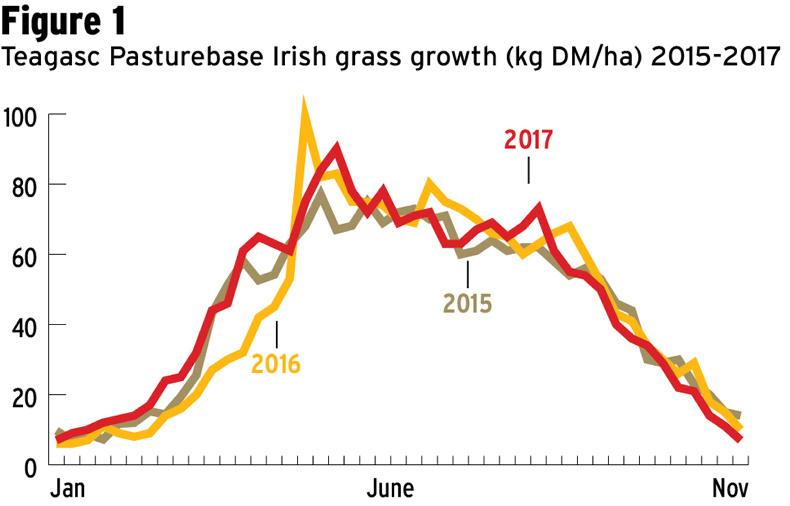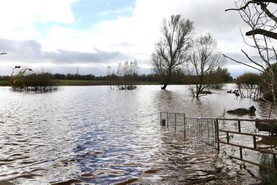By 5 May 2017, cumulative grass production was up almost 60% on 2016.
Data from Teagasc’s Pasturebase system shows that, across their measuring farms, cumulative grass production from the end of January 2017 to early May 2017 was 3.1t of grass dry matter, compared to 2t the previous year.
It’s worth noting that spring 2016 was a disastrous period for grass growth. When we compare 2017 with 2015, the difference was 13% in favour of 2017.

Grass growth during the period between mid-May and early September was similar in 2017 and 2016, averaging 71 and 72 kg DM/ha/day respectively.
This translated into a cumulative figure of around 9t.
Cumulative production in the back end of the year (15 September to 1 December) was back around 10% last year versus 2015 and 2016.
There were no significant troughs during the period, with growth rates hovering slightly under the previous year’s figures throughout.
This is reflective of the relatively mixed weather conditions for much of the country during the period.
Total grass dry matter production for 2017 on farms using the Pasturebase system was 14.7t, up from 14.0t in 2015 and 2016.
Utilisation
Growth is one thing, but getting to eat the grass is another. Parts of the country, particularly the midlands and west, experienced one of the wettest autumn periods in memory.
From the beginning of July to the end of October, the Knock Airport weather station reported 52% more rainfall than in 2016.
This severely hampered grazing plans and led to smash and grab or missed silage cuts in many cases.
In certain places, cattle have been housed since late last summer and the inability to take in silage has compounded pressure on fodder reserves.
Early out in 2018?
One silver lining potentially lies in the fact that there was a lot of grass left on fields over the winter due to the inability to graze.
Should a dry period come later in the spring, there is no reason why cattle shouldn’t be turned out earlier than normal to graze these off.
Early fertiliser will be crucial for many farmers this year to facilitate a prompt start to grazing 2018.
Read more
Follow our 27 BETTER beef farmers
Grazing in difficult conditions
By 5 May 2017, cumulative grass production was up almost 60% on 2016.
Data from Teagasc’s Pasturebase system shows that, across their measuring farms, cumulative grass production from the end of January 2017 to early May 2017 was 3.1t of grass dry matter, compared to 2t the previous year.
It’s worth noting that spring 2016 was a disastrous period for grass growth. When we compare 2017 with 2015, the difference was 13% in favour of 2017.

Grass growth during the period between mid-May and early September was similar in 2017 and 2016, averaging 71 and 72 kg DM/ha/day respectively.
This translated into a cumulative figure of around 9t.
Cumulative production in the back end of the year (15 September to 1 December) was back around 10% last year versus 2015 and 2016.
There were no significant troughs during the period, with growth rates hovering slightly under the previous year’s figures throughout.
This is reflective of the relatively mixed weather conditions for much of the country during the period.
Total grass dry matter production for 2017 on farms using the Pasturebase system was 14.7t, up from 14.0t in 2015 and 2016.
Utilisation
Growth is one thing, but getting to eat the grass is another. Parts of the country, particularly the midlands and west, experienced one of the wettest autumn periods in memory.
From the beginning of July to the end of October, the Knock Airport weather station reported 52% more rainfall than in 2016.
This severely hampered grazing plans and led to smash and grab or missed silage cuts in many cases.
In certain places, cattle have been housed since late last summer and the inability to take in silage has compounded pressure on fodder reserves.
Early out in 2018?
One silver lining potentially lies in the fact that there was a lot of grass left on fields over the winter due to the inability to graze.
Should a dry period come later in the spring, there is no reason why cattle shouldn’t be turned out earlier than normal to graze these off.
Early fertiliser will be crucial for many farmers this year to facilitate a prompt start to grazing 2018.
Read more
Follow our 27 BETTER beef farmers
Grazing in difficult conditions







 This is a subscriber-only article
This is a subscriber-only article











SHARING OPTIONS: